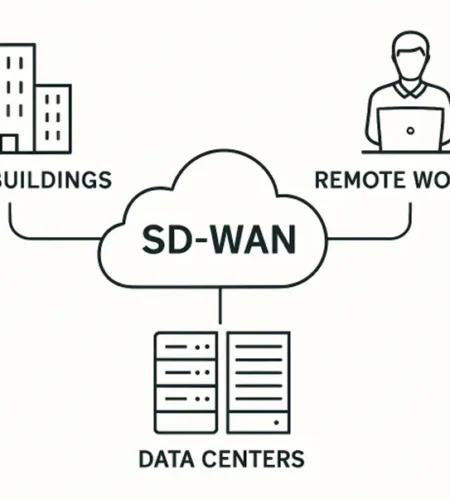What Is SD-WAN?
Network demands intensify as businesses scale and transform digitally—requiring more dynamic, reliable, and secure solutions. Enterprise-grade secure SD-WAN redefines how modern organizations connect their global locations, cloud infrastructure, and remote workforces. Unlike traditional Wide Area Networks (WANs), SD-WAN leverages centralized, software-driven management to optimize how data traverses local branch offices, data centers, and cloud environments. The foundational value of SD-WAN lies in its ability to abstract underlying network hardware and dynamically select optimal data paths based on real-time traffic patterns and business policies. This leads to unparalleled visibility, agility, and cost-effectiveness for IT teams overseeing enterprise networks. With business continuity and accessibility now more critical than ever, particularly as hybrid work becomes mainstream, SD-WAN technology makes it easier for IT leaders to ensure reliable, performant connectivity from virtually any global location. Whether organizations seek to unify diverse connectivity types, enhance the performance of cloud-based workflows, or increase security for distributed teams, SD-WAN presents a compelling and scalable solution for forward-thinking enterprises.
Key Benefits of SD-WAN for Businesses
- Agility & Flexibility: SD-WAN empowers organizations to adapt swiftly—accommodating new branch openings, mergers, or remote workforce demands without extensive hardware changes.
- Cost Savings: Businesses can reduce their capital and operational expenses by shifting from private MPLS circuits to cost-efficient broadband and LTE.
- Enhanced Security: Built-in security features such as next-generation firewalls, end-to-end encryption, and continual threat monitoring are standard in most SD-WAN solutions.
- Performance: Dynamic application-aware routing minimizes latency, jitter, and packet loss, improving productivity and user experience across critical business apps.
The global SD-WAN equipment market grew by 30% in 2022. This uptick highlights the escalating demand for robust, business-driven networks as enterprises modernize their IT landscapes.
Why SD-WAN Matters in a Cloud-Centric World
As cloud-native applications and Software as a Service (SaaS) platforms become business-critical, reliance on traditional WAN architectures exposes organizations to bottlenecks, higher latency, and inefficient resource use. SD-WAN closes this gap by offering direct, secure local access to cloud resources—prioritizing traffic based on application requirements and reducing the need to backhaul data through centralized data centers. This direct-to-cloud capability elevates end-user experience and streamlines the adoption of new digital tools across distributed environments. With a software-defined approach, enterprises can enforce uniform security and compliance policies regardless of where users connect, minimizing risk while maximizing agility. Median global enterprise bandwidth demands continue to rise, making SD-WAN’s low-latency, application-friendly routing critical for operational success in today’s distributed workforce model.
Common SD-WAN Deployment Challenges
Deploying SD-WAN isn’t without its hurdles. Many organizations invest significantly in legacy networks, requiring meticulous planning to integrate new SD-WAN layers without introducing downtime or security gaps. Ensuring compatibility across existing systems, orchestrating change management for end users and IT staff, and establishing comprehensive network policies can present considerable challenges, especially for large multi-site enterprises. Security also remains paramount, with organizations needing to ensure robust segmentation, strong encryption, and active threat detection throughout the transition. A staged deployment—beginning with a pilot program, scaling through prioritized sites, and incorporating thorough training—can help organizations mitigate disruption and realize SD-WAN benefits more quickly. Engaging with expert managed service providers is often critical for complex rollouts.
SD-WAN: Current Trends and Future Outlook
SD-WAN is increasingly perceived as a linchpin for hybrid and multi-cloud IT strategies and a substrate for advanced network security tools like SASE (Secure Access Service Edge). Industry analysts expect the next phase of SD-WAN evolution to be fueled by AI and machine learning, automating traffic steering, fault resolution, and threat mitigation to an unprecedented degree. These advancements will likely enhance SD-WAN’s ability to support edge computing, IoT initiatives, and large-scale digital transformation projects. The rapid rate of innovation means organizations must adopt SD-WAN to remain competitive and keep pace with new features and deployment paradigms. Continuous education, proactive monitoring, and adaptive security practices will be key to futureproofing SD-WAN investments.
Making the Shift: Tips for Implementing SD-WAN
- Evaluate your current network bottlenecks and pinpoint mission-critical applications that require performance boosts.
- Bridge the gap between IT and business leaders, ensuring that SD-WAN goals reflect strategic priorities and operational needs.
- Craft a stepwise migration strategy—start with pilot locations, review outcomes, and gradually expand while educating stakeholders throughout the process.
- Implement robust monitoring and adjust your SD-WAN traffic policies in response to application usage and business structure changes.
Whether you’re a small business seeking to streamline operations or an enterprise with hundreds of sites, aligning SD-WAN deployment with clear objectives and enlisting experienced technology partners will generate the greatest return on investment.
Real-World Applications and Case Studies
The impact of SD-WAN is tangible across industries. For instance, a fast-growing retail chain leveraged SD-WAN to seamlessly connect dozens of new outlets and warehouses—maintaining centralized visibility, enforcing security policies uniformly across urban and rural locations, and improving customer service with always-on connectivity.
- Retailers use SD-WAN to enable instant, high-quality connections for inventory systems and in-store applications.
- Financial service providers leverage SD-WAN to protect client information and launch digital services confidently across distributed branches.
- Global law firms utilize SD-WAN for secure, low-latency access to confidential legal documents, empowering attorneys to collaborate from anywhere.
Each case underscores the value of SD-WAN in enhancing operational efficiency, customer outcomes, and business agility—demonstrating how the technology adapts to the unique needs of distinct industries and challenges.
Conclusion
SD-WAN stands as a transformative enabler for the modern digital enterprise. Empowering organizations with flexibility, enhanced security, and seamless cloud integration provides a future-ready foundation for growth and innovation. With widespread adoption, now is an opportune moment for IT leaders to reassess their network strategies and harness the benefits of SD-WAN for enduring competitive advantage.
Also Read-The Crystal Ball of Industry: Predictive Tech Revolutionizes Asset Care


Comments